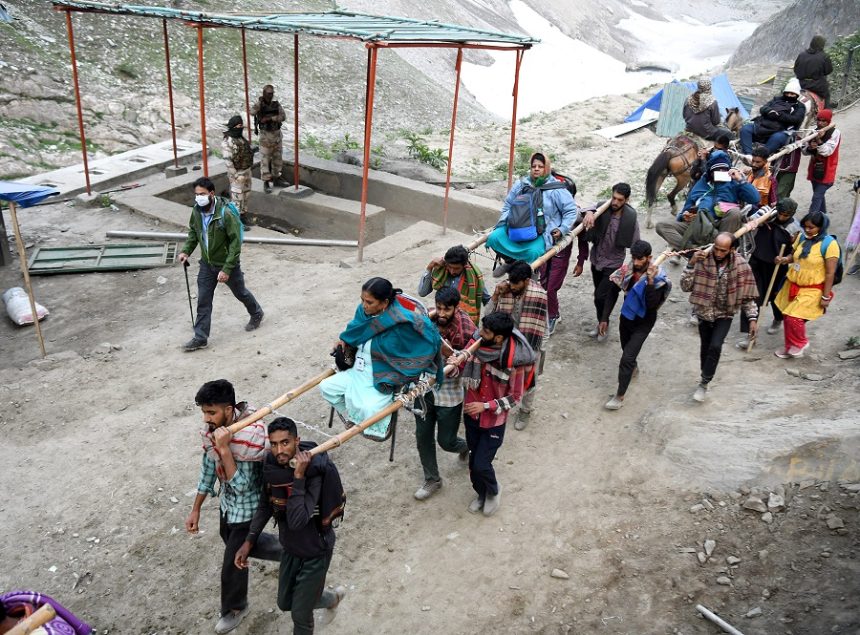The Amarnath Yatra, an annual pilgrimage to the sacred Amarnath cave, stands as a shining example of religious harmony in India. This pilgrimage holds a significant place in Hinduism as it is believed to be the abode of Lord Shiva. Nestled in the Himalayas of Central Kashmir’s Ganderbal district, the Amarnath cave remains covered in snow for most of the year, revealing itself to devotees during the summer months. The pilgrimage to this holy site, however, would not be possible without the indispensable support of the local Kashmiri Muslim community, who play a crucial role in facilitating the Yatra.
Every year, thousands of Kashmiri Muslims don traditional long woolen coats and embark on a mission to ensure the success of the Yatra. They clear the treacherous paths leading to the cave, provide palanquins, horses, and tents, and carry the pilgrims’ belongings, often on their own shoulders. This year, the Yatra commenced on June 29, and the local population in Baltal and Nunwan Pahalgam, in Central and South Kashmir, is visibly joyous, eager to welcome the influx of pilgrims.
Baltal has transformed into a vibrant hub of activity, with locals setting up tents, shops, and camping sites to ensure the comfort and safety of the pilgrims. These arrangements not only support the spiritual journey of the pilgrims but also provide much-needed employment to the local community. The economic benefits of the Yatra are significant, offering a source of income for many families in the region. This year, there is palpable optimism among the local population about the positive economic impact the Yatra will bring.
A heartwarming aspect of the Yatra is the establishment of community kitchens, or ‘langars,’ which cater to the dietary needs of the pilgrims. These kitchens are often staffed and operated by Non Locals from the different parts of India, who prepare and serve meals with a sense of devotion and hospitality. The sight of Muslims carrying yatris on their shoulders to help them complete the challenging 14-kilometer trek to the holy cave is a powerful testament to Kashmir’s syncretic culture. This act of service transcends religious boundaries, reflecting a deep-seated tradition of mutual respect and support.
Every year, thousands of Kashmiris receive permits from the Labour Department to participate in various business activities related to the Yatra. These permits enable them to engage in providing services such as transportation, lodging, and catering. The local Muslim community, standing shoulder to shoulder with the Hindu pilgrims, ensures a smooth and fulfilling journey to the sacred site. This collaboration not only facilitates the Yatra but also strengthens the bonds between the two communities, fostering a sense of unity and shared purpose.
The Forest Protection Force and Forest Department plays a vital role in managing the logistics of the Yatra. They oversee pony stands, manage prepaid ticket counters, and ensure proper ticket checking, all aimed at facilitating a seamless pilgrimage. An official from the Forest Protection Force mentioned that this year’s Yatra would provide significant employment opportunities for local workers, further enhancing the economic benefits for the region. “We are here to assist our pilgrim guests in every possible way,” the official stated, underscoring the spirit of cooperation and unity that defines the Amarnath Yatra.
The Health and Public Health Engineering (PHE) departments provide top-notch medical care and drinking water facilities to pilgrims and locals at both the Baltal and Nunwan Base Camps. Numerous doctors are deployed to work around the clock, ensuring the safety and well-being of devotees.
Security forces, including the J&K Police, play a pivotal role from the beginning of the Yatra each year, ensuring a safe journey for the pilgrims.
A devotee of Lord Shiva from Mansor, Madhya Pradesh, leading a group of 40 pilgrims, expresses gratitude to BRO and Shrine Board for enhancing the yatra infrastructure. ‘I am compelled to applaud the Shrine Board for their outstanding arrangements, which have significantly enhanced our yatra experience.
Another devotee on the Shri Amarnathji Yatra praised the arrangements and facilities provided by the administration and Shrine Board, saying, ‘The excellent management of amenities makes our yatra incredibly comfortable. Everything is perfectly organized, making this yatra a truly enjoyable experience for all devotees.’
Yatris express their gratitude daily to the District Administration of Ganderbal and Pahalgam for providing excellent facilities.
The Amarnath Yatra is more than just a religious pilgrimage; it is a symbol of India’s rich syncretic culture. The collaboration between the Hindu pilgrims and the Muslim facilitators exemplifies the harmonious coexistence that is possible when communities work together towards a common goal. In a world often divided by religious and cultural differences, the Amarnath Yatra stands as a beacon of hope, demonstrating that unity and mutual respect can pave the way for a more inclusive and harmonious society.
The Amarnath Yatra is a testament to the enduring spirit of religious harmony and unity in India. The unwavering support of the Kashmiri Muslim community, the economic opportunities created for the local population, and the spirit of cooperation exhibited by all involved are truly inspiring. As pilgrims undertake this sacred journey, they do so with the knowledge that they are part of something greater – a tradition that transcends religious boundaries and celebrates the shared humanity that unites us all.








